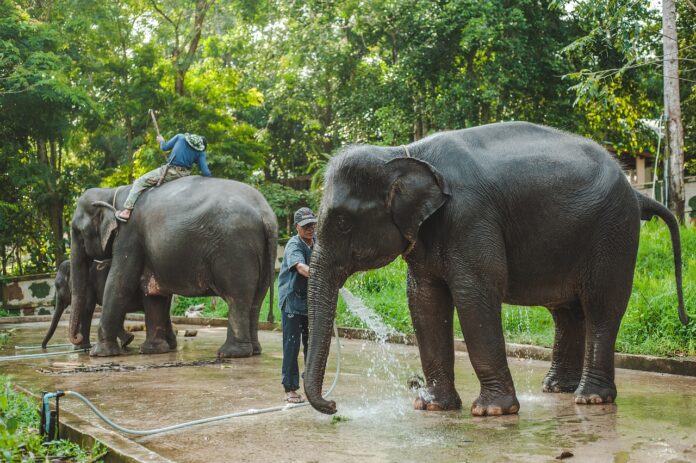The Indian (or Asian) elephant is the second-largest land animal today, surpassed only by the African savanna elephant. Adult male Indian elephants can weigh up to 5.5 tons and reach a height of 3.5 meters. Females are smaller, weighing no more than 3 tons. The smallest subspecies of Asian elephants are found on the island of Borneo, averaging around 2 tons.
The body length of an Indian elephant can reach 6.5 meters, with a tail and trunk measuring 1.5 meters each. Their tusks can grow up to 1.6 meters long and weigh as much as 25 kg. Tusks grow about 17 cm annually and are found only in males.
Just like humans, elephants can be right- or left-tusked. The more frequently used tusk becomes worn down more quickly.
In addition to tusks, Indian elephants have four molars, which are replaced six times in their lifetime. New teeth don’t replace old ones; instead, they grow behind them, pushing the worn teeth forward. The last set of teeth comes in around age 40, and by age 70, these teeth wear down, making it difficult for elephants to chew food, often leading to death from starvation.
The complex trunk of an elephant, formed from the fused nose and upper lip, is highly mobile and flexible. It contains 40,000 muscles (for comparison, the human body has only 650 muscles), giving it both strength and sensitivity. With its trunk, an elephant can lift up to 200 kg or pick up something as delicate as a chip without breaking it. The trunk can also hold over 6 liters of water, which the elephant uses as a sort of hose. When crossing deep water, elephants use their trunk as a snorkel to breathe.
Despite their size, elephants are agile and have an excellent sense of balance. They test the stability of the ground by tapping it with their trunk.
Contrary to the common misconception, elephants don’t drink through their trunk; they use it to collect water and then pour it into their mouth. They can drink up to 200 liters of water per day.
The trunk also gives elephants an exceptional sense of smell. Elephants have more olfactory receptors than any other animal—around 2,000.
Though massive, elephants can run quite fast, reaching speeds of up to 50 km/h when threatened. They are also excellent swimmers, and can locate water by smell from over 8 km away. Their large bodies give them enough buoyancy to float easily. If tired, they rest in the water while using their trunk as a snorkel.
Many scientists believe elephants’ swimming abilities are evident from their presence on the island of Sri Lanka. It is thought that ancient elephants swam from India to Sri Lanka across the Palk Strait (a distance of 150 km), resting on sandbanks along the way.
Elephants require over 250 kg of vegetation daily and spend much of their lives searching for food. They only need about 4 hours of sleep, usually while standing. The only exceptions are young or sick elephants, who may lie down to rest.
Elephants have poor eyesight, being able to clearly distinguish objects only within 10 meters. However, their hearing is much better than that of humans.
To communicate, elephants use a range of sounds, body postures, and trunk movements. Over long distances, they use infrasound to communicate. Researchers believe this ability helped many elephants survive the devastating 2004 Indian Ocean tsunami, as they may have detected the infrasound that accompanied the event.
Indian elephants are social animals, and their family groups are matriarchal, led by an adult female, along with her sisters and offspring. Only in certain cases does an adult male stay close to the group.
Male elephants reach sexual maturity between 15 and 20 years of age. After this, they experience a period called “musth” each year, which translates to “intoxication.” This period is characterized by aggressive behavior due to high testosterone levels, making them dangerous to both their fellow elephants and humans.
The average lifespan of an Indian elephant in the wild is 60 years, though in captivity, they can live up to 90 years.
Currently, the population of Indian elephants is decreasing due to poaching, conflicts with farmers over crop damage, and habitat loss. Experts estimate that the population of wild Asian elephants is shrinking by 2-5% annually.
